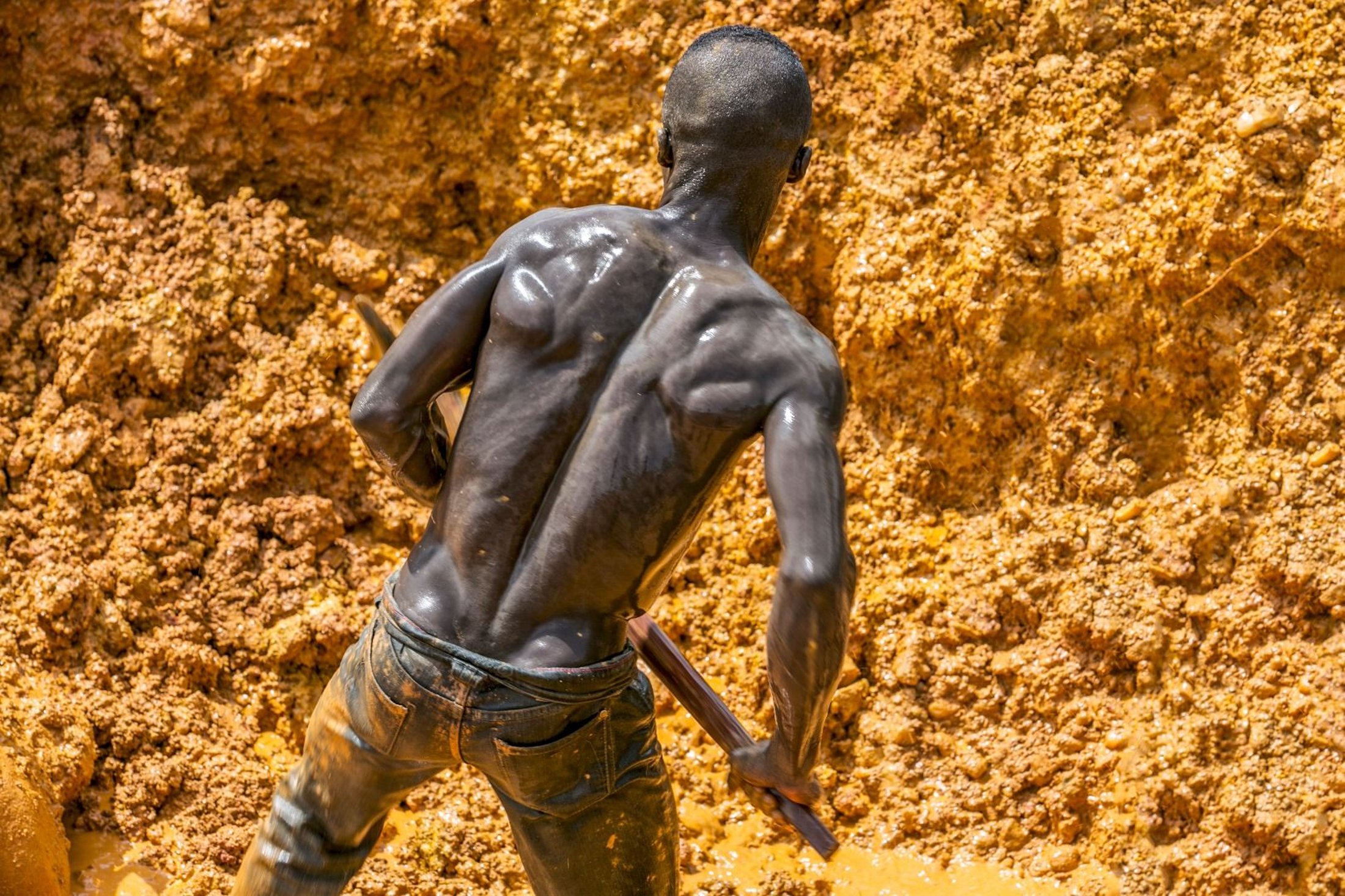When the world's markets went into free fall in 2008, the price of gold began a meteoric rise. Investments poured into the "safe haven" of gold. This virtual gold rush was mirrored on the ground in Ghana: tens of thousands of Ghanaians, lured by quick riches, turned to illegal, small scale mining. © Heidi Woodman
These mining operations are known locally as "galamsey." In every direction, one can see another galamsey operation. The term literally meaning "gather them and sell." Swarms of workers toil away under the oppressive heat and dangerous conditions. © Heidi Woodman
These photos were made at a galamsey in Kyebi, East Region, Ghana. Kyebi has been dubbed "the headquarters of galamsey." Here, a young miner emerges from a pit covered in mud. His job is to carry buckets of placer deposit (which contains the gold ore) from the sifting machine out of the pit to be washed and mixed with mercury to extract the gold. © Heidi Woodman
Across the country, vast expanses of farm land and savannah vegetation have been illegally cleared, major water sources polluted and the livelihoods of communities which rely on subsistence farming left in jeopardy. © Heidi Woodman
Young miners take a break from the unrelenting African sun. © Heidi Woodman
"It's hard, dangerous work and I know that I can get hurt or sick—but it pays well and there are no other jobs for someone like me." Kojo. © Heidi Woodman
Long after the machines leave, the land still bares its scars. The abandoned pits not only pose a physical hazard, they also contain toxic chemicals which leach into the soil and the stagnant water provides the perfect breeding ground for mosquitos, increasing the risk of malaria for surrounding communities. © Heidi Woodman
The River Birim runs through the Akyem Abuakwa state and is the lifeblood of the Eastern Region. Mining operations use cyanide and mercury to wash the rocks in the area but the run-off has destroyed life in the river and damaged surrounding vegetation and soil. © Heidi Woodman
The Ashanti people of Ghana have an ancient relationship to gold. Before contact with Europeans, they operated an advanced economy based on trading gold with neighboring countries. The most striking symbol of this bond is the "Golden Stool"—a spiritual embodiment of all the Ashantis: living, dead and yet to be born. © Heidi Woodman
Obuasi is home to the first and oldest deep rock mine site in Ghana and is the 10th largest deposit of gold in the world. In March 2014, it was announced that the mine would be halting production and retrenching 5,000+ workers. The repercussions of this decision remain to be seen. © Heidi Woodman
Local women making palm oil in Obuasi, Western Region (off mine site). The city of Obuasi itself is essentially a shanty town, however living conditions on the mine site are far superior to those off site. © Heidi Woodman
Sam Jonah ‘B’ miners settlement on the Anglogold Ashanti owned Obuasi mine site. Most people employed on the mine are housed in various miner’s settlements according to their position in the company. Concerns over re-settlement have arisen since the announcement of closure of the mine. © Heidi Woodman
A tailing dump from the South African owned Tarkwa Mine, the largest gold mine in Ghana, looms on the horizon. Tarkwa is home to the highest concentration of mining companies in Ghana and countless galamsey operations. The open pit mines in Takwa exploit tabular auriferous conglomerates, similar to those mined in the Witerwatersand Basin in south Africa. © Heidi Woodman
An open-cast mine pit on the Iduapriem Mine site, situated 10km south of Tarkwa. The mine employs a predominately Ghanaian workforce. Various large mining companies in Tarkwa region, including Idupriem, have been criticized in the past for displacing communities, destroying farmland, drying up water sources and inadequate disposal of waste material. © Heidi Woodman
Presiding member (chairman) of the Municipal Assembly (MA) of Tarkwa-Nsuaem. One of the duties of the MA is as a liaison between large-scale mining companies and the community. "In my opinion, it is now the galamsey that cause most destruction because they are so hard to control. The big companies must follow strict laws and these days they are enforced" © Heidi Woodman
One of the pits at Tarkwa mine cuts deep into the landscape. Surface mining is a less expensive method than deep rock mining, but also far more destructive to the environment. © Heidi Woodman
Children sell plantains and yams around a small community in Tarkwa. The overwhelming majority of the population of Ghana rely on subsistence farming for their livelihoods and so continued destruction of the environment threatens the futures of all these people. © Heidi Woodman
Galamsey operation in Efuanta, Tarkwa. Illegal gold mining not only takes place in open pits but also on the rivers themselves. Miners stand on floating platforms and drive machines into river bed to extract the placer deposit for sifting causing immeasurable damage to vital water sources. © Heidi Woodman
Galamsey community in Efuanta, Tarwka. Most galamsey workers are from very poor backgrounds and have little access to education. Although the money they receive is minimal, it is better than the average income and so a choice is made to engage in such work at the risk of their own health, the environment and thus the future of the community. © Heidi Woodman
There is no panacea for this gold conundrum. However, as long as the price of gold is decided more by financial speculators than by actual demand, there will be far-reaching effects on the countries where it is mined. Thus, for the time being, the future of responsible gold mining in Ghana appears bleak. © Heidi Woodman
 Ghana has a rich history in gold. Its traditions in mining and trading gold are woven into the cultural, political and economic fabric of Ghanaian society. Indeed, one could say that the country was and is quite literally built on it.
Ghana has a rich history in gold. Its traditions in mining and trading gold are woven into the cultural, political and economic fabric of Ghanaian society. Indeed, one could say that the country was and is quite literally built on it.




